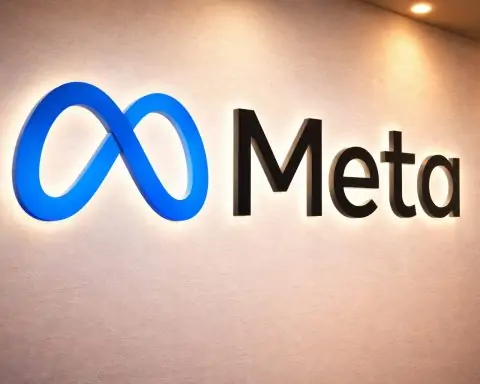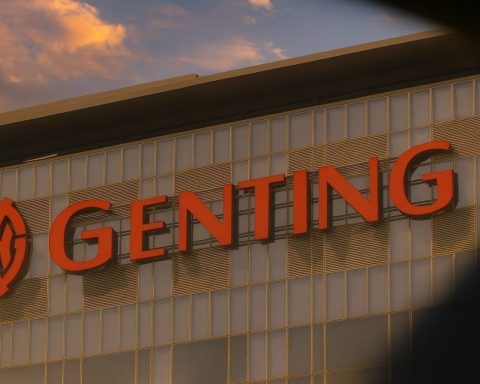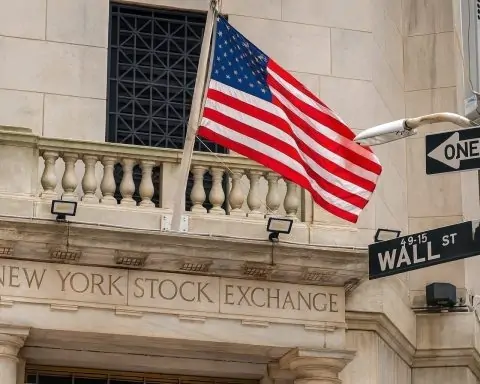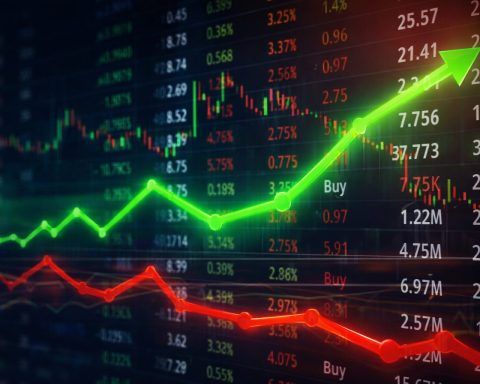Markets & Economy
- Stocks at Record Highs: Wall Street’s rally rolled on as S&P 500 notched a new closing high on Aug 14 despite mixed markets [1]. A hot U.S. inflation surprise – producer prices jumped at the fastest rate in three years – tempered expectations of aggressive Fed rate cuts [2]. “The hotter-than-expected PPI report now has investors pulling petals from a daisy saying ‘They will cut rates, they won’t cut rates’,” joked CFRA strategist Sam Stovall, reflecting the street’s uncertainty [3]. Still, traders fully expect a quarter-point Fed rate cut in September, albeit with little chance of a larger half-point move [4].
- Global Rally & Fed Watch: Equities worldwide hovered near record highs as investors largely “looked past” the U.S. inflation spike [5]. The MSCI All-Country World Index hit just shy of its all-time peak [6]. In Europe, the STOXX 600 index climbed to a five-month high on the back of upbeat earnings [7], and Japan reported an unexpected 1.0% GDP growth in Q2, beating forecasts [8]. “There’s still a small degree of war risk premium in European markets… Any resolution [in Ukraine] will pare that back,” noted Shaniel Ramjee of Pictet, as markets anticipated Trump’s high-stakes meeting with Russia’s Putin aimed at a Ukraine ceasefire [9] [10]. Meanwhile, a strong U.S. retail sales report (due Friday) was awaited for clues on consumer strength after the inflation uptick [11].
- Market Valuations & Insight: Some analysts cautioned about lofty valuations after the recent run-up. “U.S. stocks are pricey,” warned CFRA’s Sam Stovall, noting the S&P 500’s forward price/earnings ratio is about 40% above its 20-year average [12]. Bond markets reacted to the data as well – the 10-year U.S. Treasury yield jumped to ~4.29%, reflecting cooling rate-cut fervor [13]. In crypto markets, Bitcoin touched a fresh all-time high around $124,500 on Aug 14 before stabilizing [14], underscoring renewed risk appetite even as central banks signal caution.
Technology
- Intel Surges on Government Stake Rumors: Shares of chip giant Intel leapt 7.4% after a report that the U.S. government is in talks to take a stake in the company [15]. Bloomberg News broke word that the Trump administration may invest in Intel to bolster domestic semiconductor production, according to sources cited by Reuters [16]. The mere possibility of federal backing sent Intel’s stock soaring to multi-year highs in anticipation of greater support for its chipmaking ambitions. (Intel declined to comment on the report.)
- Chipmaker Warning Hits Sector: In contrast, semiconductor equipment maker Applied Materials issued a gloomy outlook that rattled tech investors. The company cut its sales and profit forecasts for the upcoming quarter, blaming “weak demand in China” and erratic orders amid U.S.–China tariff uncertainties [17]. The guidance miss – revenue projected at ~$6.7 billion vs. $7.3B expected – sent Applied shares plunging nearly 13% [18]. “Many peers have shown surprising China strength… but Applied Materials’ results show much more volatility,” observed CFRA analyst Brooks Idlet, highlighting how the trade war and export curbs have made the chip cycle unpredictable [19]. The ripple effects hit Europe’s tech sector as well: Dutch equipment giant ASML slid ~1.5% after Applied’s warning reinforced worries about tariff-related demand risks [20].
- Other Tech Moves:Cisco Systems saw its stock dip ~1.6% as its latest revenue forecast merely met expectations, offering little fresh encouragement to investors [21]. And in the advertising tech arena, reports emerged that The Trade Desk’s CEO warned of weaker spending by large brands amid tariff impacts – news that sent the ad-tech stock tumbling earlier in the week [22]. Overall, the tech sector navigated a mixed bag of geopolitical tailwinds (prospects of government support) and headwinds (trade frictions and cautious corporate spending) during the week.
Finance & Deals
- Billion-Dollar Payments Sale in Canada: Two of Canada’s largest banks are planning to sell their jointly owned payments processor Moneris, in a deal that could value the venture at up to $2 billion [23] [24]. Royal Bank of Canada (RBC) and Bank of Montreal have begun exploring a sale of Moneris – which handles one in every three card transactions in Canada – as they refocus on core banking, sources told Reuters [25]. Moneris generates about C$700 million in annual revenue, making the mooted price tag equivalent to roughly 3× sales [26]. A sale isn’t guaranteed, but bankers PJT Partners and the banks’ in-house teams are evaluating interest. The move comes amid a broader trend: with digital competition heating up, many banks are shedding payments units and finding eager buyers in specialist payment firms and private equity, who prize the steady fee revenues these businesses generate [27]. (Just last month, TD Bank struck a partnership to offload its merchant payments arm to Fiserv [28], mirroring this shift.)
- Berkshire Bets on UnitedHealth:Warren Buffett’s Berkshire Hathaway revealed a surprise new stake in healthcare giant UnitedHealth Group, sparking a relief rally in the insurer’s beaten-down shares [29] [30]. Berkshire’s latest SEC filing showed it bought 5.04 million UnitedHealth shares (worth about $1.57 billion as of June 30) [31]. UnitedHealth’s stock surged over 12% on Aug 15 upon news of the famed investor’s backing [32] [33]. The investment arrives at a critical time: UnitedHealth had been 2025’s worst-performing Dow Jones component, sliding nearly 46% year-to-date amid rising medical costs, a DOJ billing probe, a cyberattack, and even the tragic death of a senior executive [34]. Buffett’s vote of confidence buoyed hopes that the insurer’s fortunes may be turning a corner. “If the economy continues to be resilient… the Fed can begin a rate-cutting cycle without… recession and history shows this is positive for the stock market,” noted Chris Zaccarelli of Independent Advisor Alliance, suggesting UnitedHealth and other financial stocks could rebound if easing begins [35].
- Deal-Making Roundup:Accenture made waves in the cybersecurity arena by agreeing to buy Australia’s CyberCX for a reported A$1 billion (~$650M) – its largest-ever cyber acquisition [36]. Formed in 2019, Melbourne-based CyberCX has 1,400 staff and was backed by BGH Capital [37]; the deal underscores red-hot demand for cyber defenses amid a wave of high-profile hacks (Optus, Medibank, etc. in Australia) [38] [39]. In Spain, bank BBVA said it will appeal strict conditions imposed by regulators on its planned takeover of smaller rival Sabadell [40], teeing up a legal battle over bank M&A rules. And in private equity, THL Partners struck a deal to buy a majority stake in KKR’s clinical research firm Headlands Research, as sponsor activity continues in the healthcare sector [41]. Overall, global mergers & acquisitions showed pockets of strength, even as higher interest rates have made financing large takeovers trickier this year.
Energy
- Oil Prices Slip on Demand Worries: Crude oil turned lower as weak economic signals from the world’s top consumers stoked fuel demand concerns. Benchmark Brent crude fell about 0.6% to ~$66.45 per barrel on Aug 15, while U.S. WTI slid to ~$63.54 [42]. Traders were unnerved by downbeat data from China – government figures showed Chinese factory output growth slumped to an 8-month low in July and retail sales growth hit its weakest pace since December [43]. Even though China’s refiners cranked up throughput last month, much of that fuel flooded into exports, hinting at soft domestic demand [44]. In the U.S., a hotter PPI and uptick in jobless claims also raised questions about the Fed’s path, adding to demand-side anxieties for oil [45].
- Glut Fears Grow: Worries about oversupply compounded the downward pressure. OPEC+ production has been rising after earlier cuts, and major analysts see a surplus looming. Bank of America projected the oil market will average a 890,000 barrels-per-day surplus from mid-2025 to mid-2026, citing surging output from OPEC and its allies [46]. Likewise, the International Energy Agency (IEA) warned this week that the crude market looks “bloated” following the recent OPEC+ supply increases [47]. Those comments fueled expectations that oil inventories could swell if demand doesn’t keep up – a scenario that would pressure prices. On the flip side, traders are watching geopolitical developments: a potential Ukraine ceasefire from the Trump-Putin talks could ease sanctions on Russian oil and eventually boost supply [48]. For now, crude is on track to end the week slightly lower (Brent down ~0.2% weekly [49]), snapping its multi-week winning streak.
- Energy Corporate News: In corporate news, Saudi Aramco announced it is buying a stake in a giant Indian petrochemical project led by Reliance Industries (a revival of a deal shelved in 2020), marking the oil giant’s push into downstream diversification (source: Bloomberg). U.S. oilfield services firm Baker Hughes disclosed a $500 million investment in carbon capture startup Mosaic, reflecting how traditional energy firms are pivoting toward clean tech (source: CNBC). And European utility Fortum warned that unseasonably low Nordic water reservoir levels could curb its hydropower output, potentially denting profits [50]. Overall, the energy sector is balancing near-term market headwinds with strategic shifts for a lower-carbon future.
Retail & Luxury
- Shein’s Soaring Sales:Shein, the Chinese-founded fast fashion juggernaut, revealed explosive growth in its UK business. A new filing shows Shein’s UK sales hit £2.05 billion in 2024, up 32.3% from the prior year [51]. The unit’s pre-tax profit jumped 56.6%, to £38.3 million [52] [53]. Britain has become Shein’s third-largest market (after the U.S. and Germany) [54], as the ultra-cheap online retailer aggressively expanded with pop-up shops and marketing blitzes across the country. Shein – now headquartered in Singapore – has been eyeing an IPO in Hong Kong, and its robust UK performance offers a rare glimpse into the finances of the privately held firm [55]. Analysts say the growth underscores Shein’s threat to Western retailers like Zara and H&M, though the company still faces scrutiny over sustainability and supply-chain practices.
- Leadership Shake-Up at Valentino: In the luxury sector, Italian couture house Valentino announced that CEO Jacopo Venturini is stepping down, effective immediately, “to take a break for personal reasons” [56]. Venturini’s departure – by mutual agreement – comes after a difficult period of declining sales and profit at the Rome-based brand, which is famed for its red-carpet gowns. He had been on medical leave since June amid reports of his impending exit [57]. Valentino is backed by Kering (the French conglomerate bought 30% of the label in 2023 with an option to acquire 100% by 2028) [58]. His exit now leaves Valentino searching for new leadership to reignite growth and navigate a fierce luxury market. The shake-up adds to the list of creative and executive changes sweeping the luxury industry this year as houses adapt to shifting consumer trends and cost pressures. (Women’s Wear Daily first reported Venturini’s resignation.)
- Retail Earnings Roundup:Walmart (the world’s largest retailer) posted strong quarterly results mid-week and raised its annual sales forecast, citing resilient consumer demand despite inflation (shares hit a record high – source: Reuters). Target saw sales soften but managed to beat profit expectations as markdowns eased (though it issued a cautious outlook amid “shrink” and theft issues – source: CNBC). In Europe, Pandora – the Danish jeweler known for its charm bracelets – saw its stock plunge 12% after second-quarter revenue missed estimates, underscoring the uneven post-pandemic recovery in luxury spending [59]. On the positive side, UK grocery chain Lidl granted British workers their fifth pay raise in two years to help with the cost of living [60]. These mixed retail results show consumers still spending, but selectively, as high prices and economic uncertainty test brand loyalties.
Transportation
- Air Canada Strike Threat: A labor showdown in Canada threatened major travel disruption. Air Canada braced for a strike by its 10,000 unionized flight attendants set to begin just after midnight on Saturday, Aug 16, amid stalled contract talks [61]. The union is demanding higher wages and compensation for unpaid work hours, saying its members have shouldered extra duties without fair pay [62] [63]. In a bid to pressure the union, Air Canada preemptively canceled about 500 flights ahead of the deadline – roughly 20% of its schedule – potentially affecting 100,000 passengers during the busy summer travel season [64] [65]. The carrier also said it would lock out employees if the strike proceeds. The Canadian government urged both sides back to the table and warned it may intervene with arbitration to avert a travel nightmare [66]. By Friday evening, last-minute talks (facilitated by federal mediators) were ongoing under heavy political pressure to avoid a walkout. Travelers have been advised to check flight status and have contingency plans as the impasse continues.
- Global Travel & Shipping Updates: In the U.S., American Airlines pilots overwhelmingly approved a new contract with 46% pay raises, averting any labor action and setting a rich benchmark as other airline unions negotiate (source: Bloomberg). UPS officially ratified a five-year deal with its 340,000 drivers and warehouse workers – a contract that raises full-timer pay above $100k and ends the threat of a logistics shutdown (the union called it a historic win – source: Reuters). Meanwhile, the Panama Canal imposed new transit restrictions as a severe drought has lowered water levels, causing shipping delays and raising freight costs on key global trade routes (some vessels wait over 10 days to cross – source: WSJ). And Tesla announced its first shipment of Cybertruck vehicles from its Texas Gigafactory, sending a convoy of the futuristic pickups to early customers after years of production delays (Musk tweeted “Heading to delivery event!” – source: CNBC). The transportation sector thus saw labor peace in some areas, but bottlenecks and contract showdowns in others.
Real Estate
- China’s Property Pain Persists: New data underscored the ongoing real estate slump in China, a key drag on its economy. Average new home prices fell 0.3% in July from the prior month – the third straight monthly drop, according to official figures [67]. Prices are now down 2.8% compared to a year ago, with declines recorded in 60 of 70 major cities despite various local stimulus measures [68] [69]. While July’s drop was slightly smaller in top-tier cities (thanks to targeted incentives for buyers), analysts see no clear turnaround yet. “A clear turnaround and stabilisation are not yet in sight. The government should roll out a full set of property-market stabilisation measures without delay,” urged Li Kai, chief investment officer of Beijing Shengao Fund, reflecting widespread calls for more aggressive action [70]. The property meltdown – now entering its fifth year – has seen property investment tumble 12% in the first seven months of 2025 [71] and new construction starts plummet, weighing heavily on China’s GDP growth.
- Beijing Eases Homebuying Curbs: In one recent policy move, Beijing’s city government this week relaxed purchase restrictions in suburban districts to spur housing demand [72]. Qualified buyers are now allowed to purchase homes in outlying areas of the capital without the prior limits, although strict curbs still apply within the city center (inside the Fifth Ring Road) [73]. Dozens of other cities have rolled out similar incentives – from lower down-payment requirements to subsidies and tax breaks for homebuyers – in an effort to clear inventory and support property developers. So far, these piecemeal measures have only marginally slowed price declines [74]. “Given the high exposure of Chinese households to real estate, establishing a trough on prices is crucial to restoring confidence,” noted analysts at ING, emphasizing that a housing bottom could unlock pent-up consumer spending [75]. Markets are watching whether Beijing will unleash more forceful nationwide stimulus (such as interest rate cuts or easing home purchase quotas) to arrest the slide, as the property sector once accounted for a quarter of China’s economy [76].
- Global Real Estate Briefs: In the United States, 30-year mortgage rates dipped below 5% for the first time this year (to ~4.9%), spurring a modest refinance boom and a jump in new-home applications as buyers seized the rate relief (though rates remain well above 2021’s lows – source: Fox Business). Office markets remain soft globally: New York’s office vacancy hit a record ~22%, and London’s City financial district saw rents fall for a third straight quarter as firms scale back space (per JLL Research). In commercial real estate, Blackstone’s $69 billion Real Estate Income Trust (BREIT) reported a slight uptick in redemption requests in July, suggesting wealthy investors remain skittish on property funds amid higher interest costs (source: FT). And in housing policy, New Zealand officially banned foreign buyers from purchasing existing homes (effective Aug 15) in an attempt to cool its overheated housing market and improve affordability (ending a years-long debate over offshore money in property – source: Reuters). Overall, real estate markets are in a delicate flux, with high interest rates chilling some segments even as select pockets show signs of resilience or policy-driven adjustment.
Sources: Bloomberg; Reuters; CNBC; Wall Street Journal; Financial Times; company press releases.
References
1. www.reuters.com, 2. www.reuters.com, 3. www.reuters.com, 4. www.reuters.com, 5. www.reuters.com, 6. www.reuters.com, 7. www.reuters.com, 8. www.reuters.com, 9. www.reuters.com, 10. www.reuters.com, 11. www.reuters.com, 12. www.reuters.com, 13. www.reuters.com, 14. www.reuters.com, 15. www.reuters.com, 16. www.reuters.com, 17. www.reuters.com, 18. www.reuters.com, 19. www.reuters.com, 20. www.reuters.com, 21. www.reuters.com, 22. www.reuters.com, 23. www.reuters.com, 24. www.reuters.com, 25. www.reuters.com, 26. www.reuters.com, 27. www.reuters.com, 28. www.reuters.com, 29. www.reuters.com, 30. www.reuters.com, 31. www.reuters.com, 32. www.reuters.com, 33. www.reuters.com, 34. www.reuters.com, 35. www.reuters.com, 36. www.reuters.com, 37. www.reuters.com, 38. www.reuters.com, 39. www.reuters.com, 40. www.reuters.com, 41. www.reuters.com, 42. www.reuters.com, 43. www.reuters.com, 44. www.reuters.com, 45. www.reuters.com, 46. www.reuters.com, 47. www.reuters.com, 48. www.reuters.com, 49. www.reuters.com, 50. www.reuters.com, 51. www.reuters.com, 52. www.reuters.com, 53. www.reuters.com, 54. www.reuters.com, 55. www.reuters.com, 56. www.reuters.com, 57. www.reuters.com, 58. www.reuters.com, 59. www.reuters.com, 60. www.reuters.com, 61. www.reuters.com, 62. www.reuters.com, 63. www.reuters.com, 64. www.reuters.com, 65. www.reuters.com, 66. www.reuters.com, 67. www.reuters.com, 68. www.reuters.com, 69. www.reuters.com, 70. www.reuters.com, 71. www.reuters.com, 72. www.reuters.com, 73. www.reuters.com, 74. www.reuters.com, 75. www.reuters.com, 76. www.reuters.com










